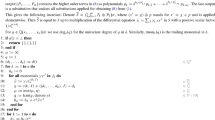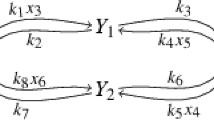Abstract
Model reduction of biochemical networks relies on the knowledge of slow and fast variables. We provide a geometric method, based on the Newton polytope, to identify slow variables of a biochemical network with polynomial rate functions. The gist of the method is the notion of tropical equilibration that provides approximate descriptions of slow invariant manifolds. Compared to extant numerical algorithms such as the intrinsic low-dimensional manifold method, our approach is symbolic and utilizes orders of magnitude instead of precise values of the model parameters. Application of this method to a large collection of biochemical network models supports the idea that the number of dynamical variables in minimal models of cell physiology can be small, in spite of the large number of molecular regulatory actors.







Similar content being viewed by others
Notes
The code can be downloaded together with supporting information from http://www.abi.bit.uni-bonn.de/index.php?id=17.
References
Chang CS (1998) On deterministic traffic regulation and service guarantees: a systematic approach by filtering. IEEE Trans Inf Theory 44(3):1097–1110
Chiavazzo E, Karlin I (2011) Adaptive simplification of complex multiscale systems. Phys Rev E 83(3):036,706
Clarke EM, Grumberg O, Peled D (1999) Model checking. MIT press, Cambridge
Deuflhard P, Heroth J (1996) Dynamic dimension reduction in ODE models. Springer, Berlin
Dolzmann A, Sturm T (1997) REDLOG: computer algebra meets computer logic. ACM SIGSAM Bullet 31(2):2–9
Feret J, Danos V, Krivine J, Harmer R, Fontana W (2009) Internal coarse-graining of molecular systems. Proc Natl Acad Sci 106(16):6453–6458. doi:10.1073/pnas.0809908106
Gawrilow E, Joswig M (2000) Polymake: a framework for analyzing convex polytopes. Polytopes Comb Comput. doi:10.1007/978-3-0348-8438-9_2
Gorban A, Karlin I (2005) Invariant manifolds for physical and chemical kinetics. Lect Notes Phys 660. Springer, Berlin
Gorban A, Radulescu O (2008) Dynamic and static limitation in reaction networks, revisited. In: Guy DW, Marin B, Yablonsky GS (eds) Advances in chemical engineering–mathematics in chemical kinetics and engineering. Elsevier. Adv Chem Eng 34:103–173. doi:10.1016/S0065-2377(08)00002-1
Gorban AN, Radulescu O (2007) Dynamical robustness of biological networks with hierarchical distribution of time scales. IET Syst Biol 1(4):238–246. doi:10.1049/iet-syb:20060083
Gorban AN, Radulescu O, Zinovyev AY (2010) Asymptotology of chemical reaction networks. Chem Eng Sci 65(7):2310–2324. doi:10.1016/j.ces.2009.09.005 (International symposium on mathematics in chemical kinetics and engineering)
Gorban AN, Shahzad M (2011) The Michaelis–Menten–Stueckelberg theorem. Entropy 13(5):966–1019
Gurobi Optimization: Gurobi optimizer reference manual (2012). http://www.gurobi.com
Haller G, Sapsis T (2010) Localized instability and attraction along invariant manifolds. SIAM J Appl Dyn Syst 9(2):611–633
Henk M, Richter-Gebert J, Ziegler GM (2004) Basic properties of convex polytopes. In: Goodman JE, O’Rourke (eds) Handbook of discrete and computational geometry. Chapman & Hall/CRC, Boca Raton, p 355
Hoops S, Sahle S, Gauges R, Lee C, Pahle J, Simus N, Singhal M, Xu L, Mendes P, Kummer U (2006) COPASI–a complex pathway simulator. Bioinformatics 22(24):3067–3074. doi:10.1093/bioinformatics/btl485
Lam S, Goussis D (1994) The CSP method for simplifying kinetics. Int J Chem Kinet 26(4):461–486
Le Novere N, Bornstein B, Broicher A, Courtot M, Donizelli M, Dharuri H, Li L, Sauro H, Schilstra M, Shapiro B, Snoep JL, Hucka M (2006) BioModels database: a free, centralized database of curated, published, quantitative kinetic models of biochemical and cellular systems. Nucleic Acids Res 34(suppl 1):D689–D691. doi:10.1093/nar/gkj092
Litvinov G (2007) Maslov dequantization, idempotent and tropical mathematics: a brief introduction. J Math Sci 140(3):426–444
Maas U, Pope SB (1992) Simplifying chemical kinetics: intrinsic low-dimensional manifolds in composition space. Combust Flame 88(3):239–264
Maclagan D, Sturmfels B (2015) Introduction to tropical geometry. American Mathematical Society, Providence
Meiske W (1978) An approximate solution of the Michaelis–Menten mechanism for quasi-steady and state quasi-equilibrium. Math Biosci 42(1):63–71
Meshkat N, Eisenberg M, DiStefano JJ (2009) An algorithm for finding globally identifiable parameter combinations of nonlinear ode models using Gröbner bases. Math Biosci 222(2):61–72
Millán MP, Dickenstein A, Shiu A, Conradi C (2012) Chemical reaction systems with toric steady states. Bullet Math Biol 74(5):1027–1065
Noel V, Grigoriev D, Vakulenko S, Radulescu O (2012) Tropical geometries and dynamics of biochemical networks application to hybrid cell cycle models. In: Feret J, Levchenko A (eds) Proceedings of the 2nd international workshop on static analysis and systems biology (SASB 2011). Electron Notes Theor Comput Sci 284:75–91. Elsevier
Noel V, Grigoriev D, Vakulenko S, Radulescu O (2014) Tropicalization and tropical equilibration of chemical reactions. In: Litvinov GL, Sergeev SN (eds) Tropical and idempotent mathematics and applications, Contemporary Mathematics, vol. 616. American Mathematical Society, Providence, pp 261–275. doi:10.1090/conm/616/12316
Pachter L, Sturmfels B (2004) Tropical geometry of statistical models. Proc Natl Acad Sci USA 101(46):16,132
Radulescu O, Gorban AN, Zinovyev A, Lilienbaum A (2008) Robust simplifications of multiscale biochemical networks. BMC Syst Biol 2(1):86. doi:10.1186/1752-0509-2-86
Radulescu O, Gorban AN, Zinovyev A, Noel V (2012) Reduction of dynamical biochemical reactions networks in computational biology. Front Genet 3:131. doi:10.3389/fgene.2012.00131
Radulescu O, Vakulenko S, Grigoriev D (2015) Model reduction of biochemical reactions networks by tropical analysis methods. Math Model Nat Phenom 10(3):124–138. doi:10.1051/mmnp/201510310
Rowley CW, Marsden JE (2000) Reconstruction equations and the Karhunen–Loève expansion for systems with symmetry. Phys D Nonlinear Phenom 142(1):1–19
Samal SS, Errami H, Weber A (2012) PoCaB: a software infrastructure to explore algebraic methods for bio-chemical reaction networks. In: Gerdt VP, Koepf W, Mayr EW, Vorozhtsov EV (eds) Computer algebra in scientific computing. Lecture Notes in Computer Science, vol. 7442, pp. 294–307. Springer, Berlin. doi:10.1007/978-3-642-32973-9_25
Samal SS, Grigoriev D, Fröhlich H, Radulescu O (2015) Analysis of reaction network systems using tropical geometry. In: Gerdt VP, Koepf W, Seiler WM, Vorozhtsov EV (eds) Computer algebra in scientific computing—17th international workshop (CASC 2015), Lecture Notes in Computer Science. Springer, Aachen, vol. 9301, pp. 422–437. doi:10.1007/978-3-319-24021-3_31
Savageau M, Voit E (1987) Recasting nonlinear differential equations as S-systems: a canonical nonlinear form. Math Biosci 87(1):83–115
Savageau MA, Coelho PM, Fasani RA, Tolla DA, Salvador A (2009) Phenotypes and tolerances in the design space of biochemical systems. Proc Natl Acad Sci 106(16):6435–6440
Segel LA (1988) On the validity of the steady state assumption of enzyme kinetics. Bullet Math Biol 50(6):579–593
Segel LA, Slemrod M (1989) The quasi-steady-state assumption: a case study in perturbation. SIAM Rev 31(3):446–477
Simon I (1988) Recognizable sets with multiplicities in the tropical semiring. In: Chytil MP, Koubek V, Janiga L (eds) Mathematical foundations of computer science. Lecture Notes in Computer Science, vol. 324. Springer, Berlin, pp 107–120
Soliman S, Fages F, Radulescu O (2014) A constraint solving approach to model reduction by tropical equilibration. Algorithms Mol Biol 9(1):24. doi:10.1186/s13015-014-0024-2
Sturmfels B (2002) Solving systems of polynomial equations. CBMS Regional Conference Series in Math, no. 97, American Mathematical Society, Providence
Surovtsova I, Simus N, Lorenz T, König A, Sahle S, Kummer U (2009) Accessible methods for the dynamic time-scale decomposition of biochemical systems. Bioinformatics 25(21):2816–2823. doi:10.1093/bioinformatics/btp451
Tikhonov AN (1952) Systems of differential equations containing small parameters in the derivatives. Matematicheskii Sbornik 73(3):575–586
Tyson JJ (1991) Modeling the cell division cycle: cdc2 and cyclin interactions. Proc Natl Acad Sci 88(16):7328–7332
Weber A, Sturm T, Abdel-Rahman EO (2011) Algorithmic global criteria for excluding oscillations. Bullet Math Biol 73(4):899–916. doi:10.1007/s11538-010-9618-0
Weispfenning V (1988) The complexity of linear problems in fields. J Symb Comput 5(1&2):3–27
Zobeley J, Lebiedz D, Kammerer J, Ishmurzin A, Kummer U (2005) A new time-dependent complexity reduction method for biochemical systems. In: Priami C et al. (eds) Transactions on computational systems biology I. Lecture Notes in Computer Science (Lecture Notes in Bioinformatics) 3380. Springer, Berlin, pp 90–110. doi:10.1007/b107357
Acknowledgments
This work has been supported by the French ModRedBio CNRS Peps, and EPIGENMED Excellence Laboratory projects. D.G. is grateful to the Max-Planck Institut für Mathematik, Bonn for its hospitality during writing this paper and to Labex CEMPI (ANR-11-LABX-0007-01).
Author information
Authors and Affiliations
Corresponding author
Rights and permissions
About this article
Cite this article
Samal, S.S., Grigoriev, D., Fröhlich, H. et al. A Geometric Method for Model Reduction of Biochemical Networks with Polynomial Rate Functions. Bull Math Biol 77, 2180–2211 (2015). https://doi.org/10.1007/s11538-015-0118-0
Received:
Accepted:
Published:
Issue Date:
DOI: https://doi.org/10.1007/s11538-015-0118-0




